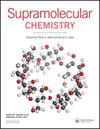阳离子环番-瓜类bbbb_uril:对中性苯酚客体表现出协同识别的宿主-宿主配合物
IF 2.6
4区 化学
Q3 CHEMISTRY, MULTIDISCIPLINARY
引用次数: 2
摘要
葫芦[10]uril (CB[10])在H2O和DMSO中与四聚环烷形成稳定的主-客体配合物。在CB[10]中封装后,环烷对阴离子的亲和力减弱,这是由于CB[10]上的电负性羰基氧提供了电荷排斥环境,并且封装固定了环烷的构象。有趣的是,这些配合物对中性苯酚客体表现出积极的协同作用,形成杂三元配合物。x -射线单晶分析证实的多重氢键相互作用以及疏水效应是形成杂三元包合物的驱动力。图形抽象本文章由计算机程序翻译,如有差异,请以英文原文为准。
Cationic cyclophanes-in-cucurbit[10]uril: host-in-host complexes showing cooperative recognition towards neutral phenol guests
ABSTRACT Cucurbit[10]uril (CB[10]) is found to form stable host-guest complexes with tetracationic cyclophanes in H2O and DMSO. Upon encapsulation in CB[10], the affinity of cyclophanes towards anions is weakened, due to electronegative carbonyl oxygens on CB[10] providing charge repulsion environment, and encapsulation fixing the conformation of cyclophanes. Interestingly, these complexes show positively cooperative effects towards neutral phenol guests to form heteroternary complexes. The driving force for the formation of heteroternary inclusion complexes is multiple hydrogen bonding interactions confirmed by X-ray single crystal analysis, as well as hydrophobic effects. GRAPHICAL ABSTRACT
求助全文
通过发布文献求助,成功后即可免费获取论文全文。
去求助
来源期刊

Supramolecular Chemistry
化学-化学综合
CiteScore
3.60
自引率
3.00%
发文量
5
审稿时长
2.7 months
期刊介绍:
Supramolecular Chemistry welcomes manuscripts from the fields and sub-disciplines related to supramolecular chemistry and non-covalent interactions. From host-guest chemistry, self-assembly and systems chemistry, through materials chemistry and biochemical systems, we interpret supramolecular chemistry in the broadest possible sense. Interdisciplinary manuscripts are particularly encouraged. Manuscript types include: high priority communications; full papers; reviews, and; Methods papers, techniques tutorials highlighting procedures and technologies that are important to the field. We aim to publish papers in a timely fashion and as soon as a paper has been accepted and typeset it will be published in electronic form on the Latest articles section of the website. The two most important review criteria are that the paper presents high-quality work that fits generally into the broad spectrum of activities in the supramolecular chemistry field. Under normal circumstances, Supramolecular Chemistry does not consider manuscripts that would be more suitable in a highly specialized journal. This includes, but is not limited to, those based mostly or exclusively on topics such as solid state/X-ray structures, computational chemistry, or electrochemistry. .
The two most important review criteria are that the paper presents high-quality work that fits generally into the broad spectrum of activities in the supramolecular chemistry field.
 求助内容:
求助内容: 应助结果提醒方式:
应助结果提醒方式:


